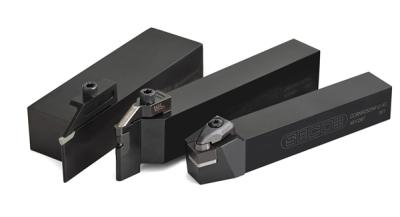
Seco, Troy, Mich., recently expanded the roughing and semi-finishing performance capabilities of its Secomax CS100 sialon ceramic grade inserts by adding inserts with T-style edge preparation to the line, according to a company news release. Featuring a free-cutting, sharp geometry, the new inserts are said to bring strength, stability and performance longevity to the machining of nickel-based superalloys in unstable conditions.
Said to be well-suited for turning applications that require tight tolerances and low cutting forces, the T-style (chamfered) CS100 inserts are available in 20-degree chamfers that range from 0.002" to 0.004" (0.05mm to 0.1mm) in width. The sharp, negative reinforced cutting edges on these inserts reportedly absorb some of the high cutting force and pressure that would otherwise be placed on the machine setups and workpieces. As a result, the inserts are said to eliminate the risk of workpiece deformation, especially in thin-walled components.
The characteristics of the T-style inserts complement the existing S-style (chamfered and honed) CS100 products designed to handle high cutting forces in rigid, stable machining conditions, according to Seco. Collectively, the T-style and S-style inserts in the CS100 line have high abrasion resistance and superior toughness that extends tool life and allows for high cutting speeds when processing challenging materials such as Inconel, MAR, RENE and Waspaloy.
Contact Details
Related Glossary Terms
- cutting force
cutting force
Engagement of a tool’s cutting edge with a workpiece generates a cutting force. Such a cutting force combines tangential, feed and radial forces, which can be measured by a dynamometer. Of the three cutting force components, tangential force is the greatest. Tangential force generates torque and accounts for more than 95 percent of the machining power. See dynamometer.
- edge preparation
edge preparation
Conditioning of the cutting edge, such as a honing or chamfering, to make it stronger and less susceptible to chipping. A chamfer is a bevel on the tool’s cutting edge; the angle is measured from the cutting face downward and generally varies from 25° to 45°. Honing is the process of rounding or blunting the cutting edge with abrasives, either manually or mechanically.
- superalloys
superalloys
Tough, difficult-to-machine alloys; includes Hastelloy, Inconel and Monel. Many are nickel-base metals.
- turning
turning
Workpiece is held in a chuck, mounted on a face plate or secured between centers and rotated while a cutting tool, normally a single-point tool, is fed into it along its periphery or across its end or face. Takes the form of straight turning (cutting along the periphery of the workpiece); taper turning (creating a taper); step turning (turning different-size diameters on the same work); chamfering (beveling an edge or shoulder); facing (cutting on an end); turning threads (usually external but can be internal); roughing (high-volume metal removal); and finishing (final light cuts). Performed on lathes, turning centers, chucking machines, automatic screw machines and similar machines.

